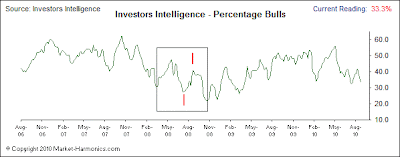I received a letter from
Morningstar today. Danger I find within it! The degree to which risk in the stock market can be downplayed these days is frightening. Here's what the letter said...
Dear Fellow Investor,
The year I started at Morningstar, interest rates were spiking and the NAFTA-inspired Mexican equity bubble became a panic. That was 1994. Since then, we've seen a Russian default mess, an Asian meltdown, the bursting of the Internet bubble, the attacks of 9/11, two wars, the subprime housing collapse, and much more than you care to read here.
In spite of all that, we still managed to experience a huge bull market, and most of the top money managers and investment firms are still standing.
What's the secret? Buy-and-hold investing still works, while trendier strategies have their moments and go bust. This down market is a great time to invest with good managers--provided you're in it for the long term. You just have to know where to put your money.
The stock market has gone nowhere for more than ten years. So, I am not at all clear on this "huge bull market" experienced over the interim.
Just very briefly ... "invest with good managers" ... be "in it for the long term" ... "know where to put your money" ... your response should be duh, duh, and duh. No kidding!
Of course "buy-and-hold investing" still works! However, I would challenge the author to show me a portfolio of stocks (out of the thousands traded) — a portfolio (or fund) that's widely available to 401(k) investors — whose performance over the past ten years outmatched the strategy I advocate.
Diversify your 401(k) investments in fund choices 100% committed to the U.S. stock market, but only when your risk of loss is low. Otherwise, move your 401(k) savings into a safe money-market fund. Plan "A" and Plan "B" — very simple.
Here's my record ever since I began using this strategy (and broadcasting my position)...
- January 2000: Moved 401(k) savings to money-market fund
- February 2003: Switched out of money-market fund and into funds 100% invested in the U.S. stock market
- May 2008: Moved back into money-market fund
- November 2008: Switched back into funds 100% invested in the U.S. stock market (largely a short-term, speculative play)
So, what's the risk of loss in the stock market right now?
Believe it or not, for the moment it is slight. That's not to say, however, there's no reason to be concerned and alert.

The consensus opinion of investment newsletter writers is no "be all, end all" indicator. In other words, widespread bearishness does not guarantee the stock market will move higher. Yet it does increase the odds. (Since most money managers fail to outperform the S&P 500, you can look at investment newsletter writer sentiment as a "contrary indicator." Generally speaking, if they're too bullish, watch out for a falling stock market; if they're extraordinarily bearish, stocks could pop.)
As for supposing the stock market's long-term fortunes look bright, all because there is a ton of bearishness among investment newsletter writers, just look at last year's record. The message is clear. The stock market can fall hard even amidst sentiment typical at bottoms. Like I said, this is no "be all, end all" indicator.
And don't lose sight of the fact all major stock indexes currently trade below their respective 200-day moving averages. There's good reason to remain concerned about the future here.
For now I agree with Morningstar's positive view. However sometime in the not-too-distant future I believe their bent might prove dangerous to most investors.
Risk should be a concern of every 401(k) investor, particularly in light of the fact that, when it comes to your retirement time is of the essence. You simply cannot afford taking big losses.





